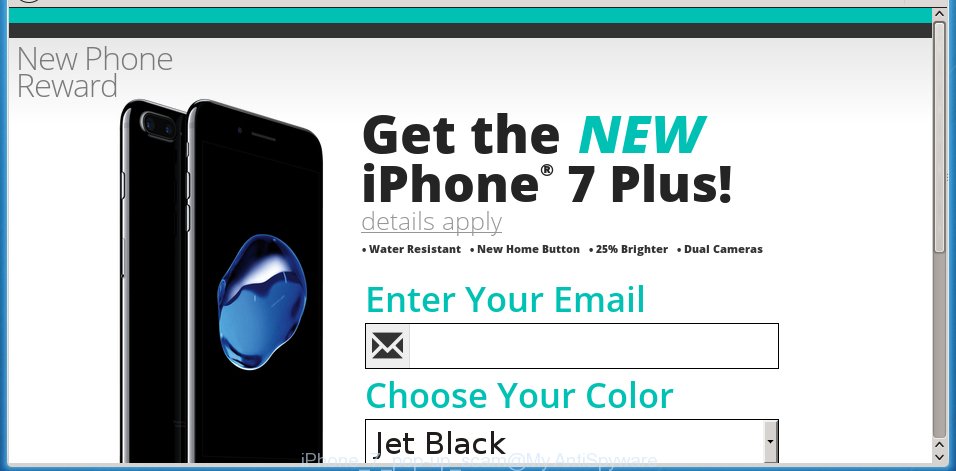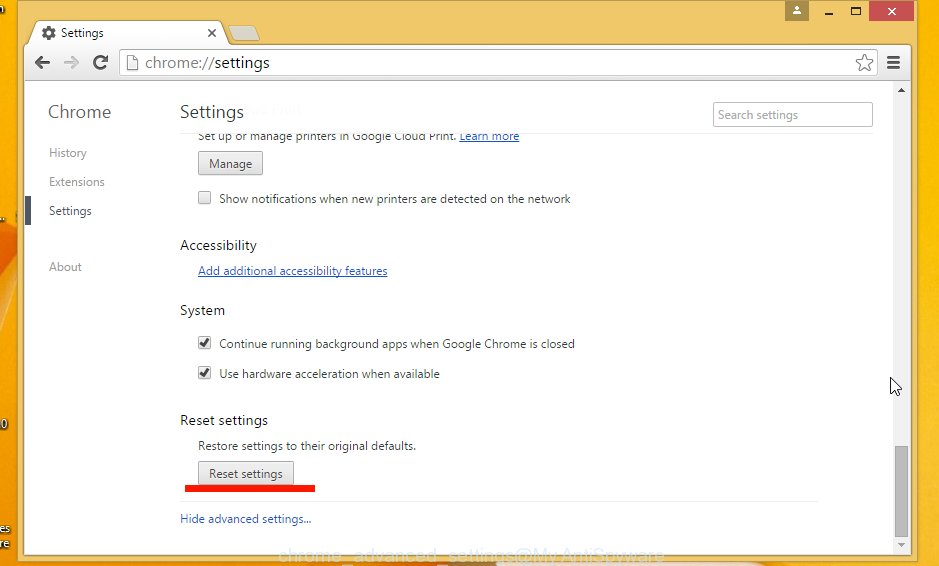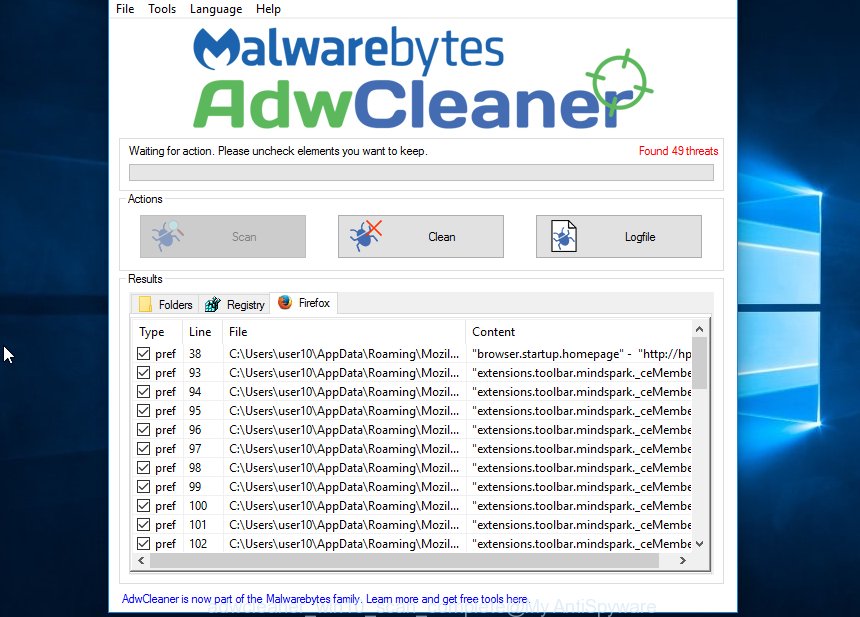The iPhone 7 pop-up telling you had been selected by Apple to win an iPhone 7 or get an iPhone 7 for free is a classic bait-and-switch scam. If these spammy ads or popups are constantly popping within your web-browser that is a sign of ‘ad-supported’ software (also known as adware) which installed on your personal computer. I think you definitely want to remove these unwanted ads. For this purpose, you need to follow the instructions below that will allow you to remove iPhone 7 pop-up scam and clean your PC system from the adware using the standard features of Windows and some proven free programs.

Most often, the adware affects the most common browsers such as the Google Chrome, Microsoft Internet Explorer, FF and Microsoft Edge. But such the malicious software as well may infect another web-browsers by changing its shortcuts (adding an argument like ‘http://site.address’ into Target field of a web-browser’s shortcut). So every time you run the browser, it’ll reroute to the annoying iPhone 7 scam. Even if you setup a new startpage, an unwanted web page will be the first thing you see when you launch the Firefox, Chrome, Internet Explorer and Microsoft Edge.
What is more, the ‘ad supported’ software may show advertisements depend on a web site that you are visiting. That is, it’s clear that this ad supported software, without your permission, steals your private information such as: your ip address, what is a web page you are viewing now, what you are looking for on the Internet, which links you are clicking, and much, much more. The adware may monetize its functionality by collecting data from your browsing sessions and selling it to third party companies. This puts your personal information at a security risk.
We recommend to remove the ad-supported software, which redirects your web-browser on the iPhone 7 scam ads, as soon as you found this problem, as it can direct you to web-resources which may load other malicious software on your computer.
How did you get infected with iPhone 7 pop-ups
The ad supported software spreads along with various free software, as a supplement, which is installed automatically. This is certainly not an honest way to get installed onto your machine. To avoid infecting of your PC and side effects in the form of the iPhone 7 unwanted advertisements, you should always carefully read the ‘Terms of Use’ and the ‘Software license’. Additionally, always select Manual, Custom or Advanced install mode. This allows you to disable the installation of unnecessary and often harmful programs.
How to manually remove iPhone 7 pop up ads
The following instructions is a step-by-step guide, that will assist you manually remove iPhone 7 scam from the Chrome, Mozilla Firefox, MS Edge and IE.
- Remove suspicious and unknown software by using Windows Control Panel
- Remove iPhone 7 pop up ads from Firefox
- Remove iPhone 7 pop-up ads from Chrome
- Remove iPhone 7 scam ads from Microsoft Internet Explorer
- Disinfect the browser’s shortcuts
- Remove unwanted Scheduled Tasks
Remove suspicious and unknown software by using Windows Control Panel
Press Windows key ![]() , then click Search
, then click Search ![]() . Type “Control panel”and press Enter. If you using Windows XP or Windows 7, then click “Start” and select “Control Panel”. It’ll display the Windows Control Panel as shown on the image below.
. Type “Control panel”and press Enter. If you using Windows XP or Windows 7, then click “Start” and select “Control Panel”. It’ll display the Windows Control Panel as shown on the image below.

Next, click “Uninstall a program” ![]()
It will show a list of all software. Scroll through the all list and remove any suspicious and unknown programs.
Remove iPhone 7 pop up ads from Firefox
If the Mozilla Firefox settings have been changed by the adware, then resetting it to the default state can help you to get rid of the redirect onto iPhone 7 scam web page.
First, run the Firefox and click ![]() button. It will display the drop-down menu on the right-part of the web-browser. Next, press the Help button (
button. It will display the drop-down menu on the right-part of the web-browser. Next, press the Help button (![]() ) as shown below.
) as shown below.

In the Help menu, select the “Troubleshooting Information” option. Another way to open the “Troubleshooting Information” screen – type “about:support” in the web browser address bar and press Enter. It will display the “Troubleshooting Information” page as shown in the figure below. In the upper-right corner of this screen, click the “Refresh Firefox” button.

It will display the confirmation dialog box, click the “Refresh Firefox” button. The Mozilla Firefox will start a process to fix your problems that caused by the ‘ad supported’ software. When it’s complete, click the “Finish” button
Remove iPhone 7 pop-up ads from Chrome
Like other modern browsers, the Google Chrome has the ability to reset the settings to their default values and thereby remove the redirect to iPhone 7 unwanted ads that is caused by the ad supported software.
At first, start the Chrome. Next, press the button in the form of three horizontal stripes (![]() ). It will appear the main menu. Click on the option named “Settings”. Another way to show the Chrome’s settings – type chrome://settings in the web-browser adress bar and press Enter.
). It will appear the main menu. Click on the option named “Settings”. Another way to show the Chrome’s settings – type chrome://settings in the web-browser adress bar and press Enter.

The web browser will open the settings screen. Scroll down to the bottom of the page and click on the “Show advanced settings” link. Now scroll down until the “Reset settings” section is visible, as on the image below and click the “Reset settings” button.

The Google Chrome will display the confirmation dialog box. You need to confirm your action, press the “Reset” button. The program will start the procedure of cleaning. When it is complete, the web browser settings including the ‘block pop-ups’ option back to the values that have been when the Chrome was first installed on your computer.
Remove iPhone 7 scam ads from Microsoft Internet Explorer
First, start the IE, then click ![]() button. Next, press “Internet Options” as shown in the figure below.
button. Next, press “Internet Options” as shown in the figure below.

In the “Internet Options” screen select the Advanced tab. Next, press the “Reset” button. The IE will display the “Reset Internet Explorer” settings prompt. Select the “Delete personal settings” check box and press Reset button.

You will now need to restart your PC system for the changes to take effect. It will restore the Microsoft Internet Explorer’s settings such as homepage, new tab page and search engine by default to default state, disable ad-supported internet browser’s extensions and thereby get rid of the redirect to iPhone 7 unwanted web site.
Disinfect the browser’s shortcuts
Once the adware is started, it can also change the internet browser’s shortcuts, adding an argument like “http://site.address” into the Target field. Due to this, every time you start the web browser, it will be rerouted to an annoying ads.
To clear the browser shortcut, right-click to it and select Properties. On the Shortcut tab, locate the Target field. Click inside, you will see a vertical line – arrow pointer, move it (using -> arrow key on your keyboard) to the right as possible. You will see a text which begins with “http://” which has been added here. You need to remove it.

When the argument is removed, click the OK button. You need to clean all shortcuts of all your internet browsers, as they may be infected too.
Remove unwanted Scheduled Tasks
Once installed, the adware can add a task in to the Windows Task Scheduler Library. Due to this, every time when you open your computer, it will display iPhone 7 unwanted scam web-page. So, you need to check the Task Scheduler Library and remove all tasks that have been created by unwanted software.
Press Windows and R keys on your keyboard at the same time. It will display a prompt which titled with Run. In the text field, type “taskschd.msc” (without the quotes) and click OK. Task Scheduler window opens. In the left-hand side, click “Task Scheduler Library”, as shown below.

Task scheduler, list of tasks
In the middle part you will see a list of installed tasks. Select the first task, its properties will be display just below automatically. Next, click the Actions tab. Necessary to look at the text which is written under Details. Found something such as “explorer.exe http://site.address” or “chrome.exe http://site.address” or “firefox.exe http://site.address”, then you need remove this task. If you are not sure that executes the task, then google it. If it’s a component of the malicious program, then this task also should be removed.
Further click on it with the right mouse button and select Delete as shown on the image below.

Task scheduler, delete a task
Repeat this step, if you have found a few tasks that have been created by unwanted applications. Once is finished, close the Task Scheduler window.
How to get rid of iPhone 7 pop-up scam automatically
We recommend using the Malwarebytes Free. You can download and install this utility to detect adware and delete it, from the link below. When installed and updated, the free malware remover will automatically scan and detect all threats present on the computer.
327071 downloads
Author: Malwarebytes
Category: Security tools
Update: April 15, 2020
Once installed, the Malwarebytes will try to update itself and when this procedure is finished, click “Scan Now” button to begin checking your system for the adware and malware. During the scan it will detect all threats present on your computer. In order to remove all threats, simply press “Quarantine Selected” button.
The Malwarebytes is a free application that you can use to remove all detected folders, files, services, registry entries and so on. To learn more about the Malwarebytes, we recommend you to read and follow the instructions or the video guide below.
How to stop iPhone 7 spammy ads and pop-ups
To increase your security and protect your computer against new unwanted advertisements and malicious web pages, you need to use an application that stops access to harmful ads and web-sites. Moreover, the program can stop the open of intrusive advertising, which also leads to faster loading of web-pages and reduce the consumption of web traffic.
- Download AdGuard program from the following link.
Adguard download
26843 downloads
Version: 6.4
Author: © Adguard
Category: Security tools
Update: November 15, 2018
- Once downloading is finished, launch the downloaded file. You will see the “Setup Wizard” window. Follow the prompts.
- Once the install is finished, click “Skip” to close it and use the default settings, or press “Get Started” to see a quick tutorial that will help you get to know AdGuard better.
- In most cases, the default settings are enough and you do not need to change anything. Each time, when you launch your machine, AdGuard will run automatically and stop pop-up ads, iPhone 7 spammy ads, as well as other harmful or misleading web pages. For an overview of all the features of the program, or to change its settings you can simply double-click on the AdGuard icon, that is located on your Windows desktop.
Remove iPhone 7 pop-up ads and malicious extensions with AdwCleaner.
If MalwareBytes cannot delete the unwanted iPhone 7 pop-up ads from the Chrome, IE, Firefox and Microsoft Edge, then we suggests to use the AdwCleaner. AdwCleaner is a free removal tool for adware, browser hijackers, PUPs and toolbars.
Download AdwCleaner from the link below.
225545 downloads
Version: 8.4.1
Author: Xplode, MalwareBytes
Category: Security tools
Update: October 5, 2024
Once the download is complete, open the directory in which you saved it. Double click the AdwCleaner icon. Once this utility is opened, you will see a screen like below.

Now, press the “Scan” button . This will start scanning the whole system to find out malicious extensions and ad supported software that displays the iPhone 7 spammy ads. When the system scan is complete, it will display a scan report as shown below.

Review the report and then click “Clean” button. It will open a prompt. Click “OK”. When the cleaning procedure is complete, AdwCleaner may ask you to reboot your personal computer.
Look at the following video, which completely explains the process of using the AdwCleaner to delete adware, browser hijackers and other dangerous applications.
Finish words
Now your computer should be free of the iPhone 7 pop-up ads. Remove AdwCleaner. We suggest that you keep AdGuard (to help you stop unwanted popup ads and unwanted malicious pages) and Malwarebytes (to periodically scan your system for new malware and ‘ad supported’ software). Make sure that you have all the Critical Updates recommended for Windows OS. Without regular updates you WILL NOT be protected when new dangerous programs and adware are released.
If you are still having problems while trying to remove iPhone 7 pop-ups from your machine, then ask for help in our Spyware/Malware removal forum.

















